

Oxygen Sensor Removal/Installation
Refer to the Oxygen Sensor Removal/Installation (Equipped Models) in the Electrical System chapter.
Oxygen Sensor Inspection
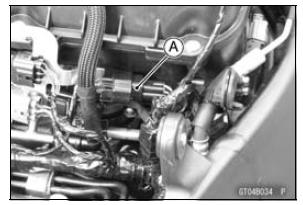
Main Harness [B] Oxygen Sensor [C]
Special Tool - Measuring Adapter: 57001-1700
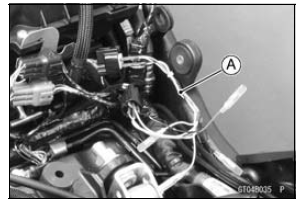
Oxygen Sensor Output Voltage Connections to Adapter: Digital Meter (+) → R (sensor BK) lead Digital Meter (–) → BK (sensor GY) lead
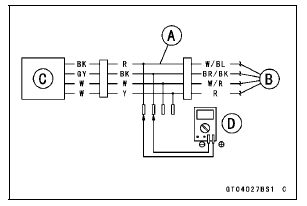
Do not disconnect the air switching valve connector [B].

Air Cleaner Housing (see Air Cleaner Housing Installation in the Fuel System (DFI) chapter) Fuel Tank (see Fuel Tank Installation in the Fuel System (DFI) chapter)
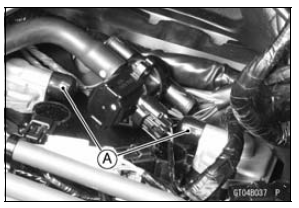
Measuring Adapter [A]
Output Voltage (with Plugs, Rich) Standard: DC 0.8 V or more
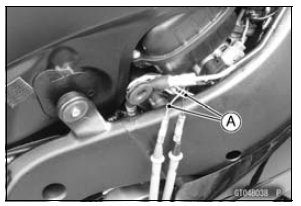
| WARNING The engine gets extremely hot during normal operation and can cause serious burns. Never touch a hot engine. |
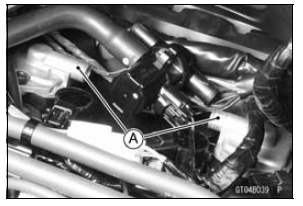
Air Cleaner Housing (see Air Cleaner Housing Installation in the Fuel System (DFI) chapter) Fuel Tank (see Fuel Tank Installation in the Fuel System (DFI) chapter)
Output Voltage (without Plugs, Lean) Standard: DC 0.24 V or less
If the reading is out of the standard (with plugs: 0.8 V or more, without plugs: 0.24 V or less), remove the ECU and check the wiring for continuity between harness connectors.
Special Tool - Hand Tester: 57001-1394
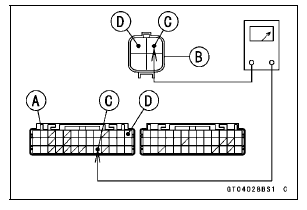
Disconnect the ECU and sensor connectors.
Wiring Continuity Inspection ECU Connector [A] ←→ Oxygen Sensor Connector [B] W/BL lead (ECU terminal 35) [C] BR/BK lead (ECU terminal 13) [D]
If the wiring is good, replace the sensor.
If the reading is within the standard (with plugs: 0.8 V or more, without plugs: 0.24 V or less), check the ECU for its ground and power supply (see ECU Power Supply Inspection in the Fuel System (DFI) chapter).
If the ground and power supply are good, replace the ECU (see ECU Removal/Installation in the Fuel System (DFI) chapter).
Oxygen Sensor Circuit
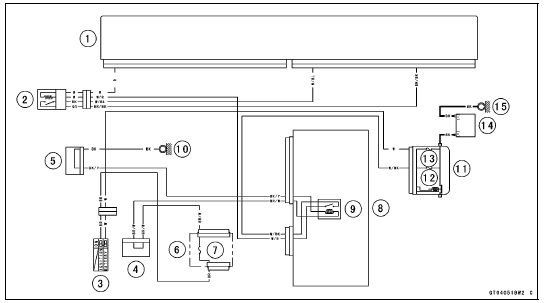
1. ECU
2. Oxygen Sensor
3. Ignition Switch
4. Joint Connector F
5. Joint Connector A
6. Fuse Box 1
7. Ignition Fuse 15 A
8. Relay Box
9. ECU Main Relay
10. Frame Ground 3
11. Starter Relay
12. ECU Fuse 15 A
13. Main Fuse 30 A
14. Battery
15. Engine Ground
 Subthrottle Sensor Resistance Inspection
Subthrottle Sensor Resistance Inspection Exhaust Butterfly Valve Actuator Sensor (Service Code 34)
Exhaust Butterfly Valve Actuator Sensor (Service Code 34)Transmission Assy Removal
Remove:
Engine Sprocket (see Engine Sprocket Removal in the
Final Drive chapter)
Gear Position Switch (see Gear Position Switch Removal
in the Electrical System chapter)
Collar [A]
O-ring [B]
Remove:
Clutch (see Clutch Removal in the Clutch chapter)
Shift Shaft Assembly ...
Drive Chain Wear Inspection
Remove the chain cover (see Drive Chain Removal/Installation
in the Final Drive chapter).
Rotate the rear wheel to inspect the drive chain for damaged
rollers, and loose pins and links
If there is any irregularity, replace the drive chain.
Lubricate the drive chain if it appears dry.
...
Ignition Switch Replacement
Remove:
Air Cleaner Housing (see Air Cleaner Housing Removal
in the Fuel System (DFI) chapter)
Disconnect the lead connectors [A].
Remove:
Steering Stem Head (see Stem, Stem Bearing Removal
in the Steering chapter)
Using a small chisel or punch [A], turn out the Torx bolts.
...